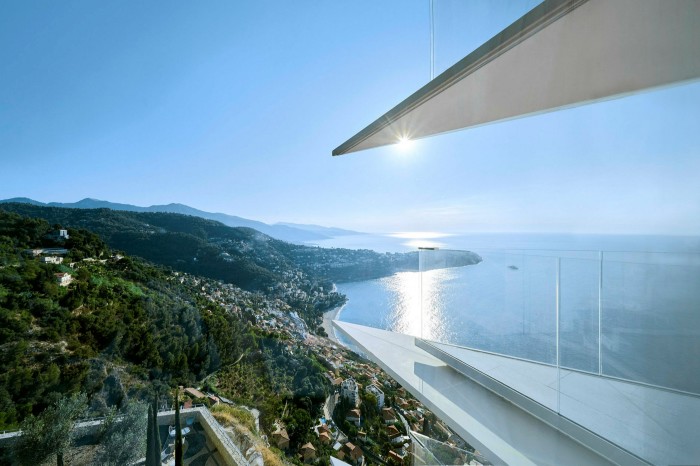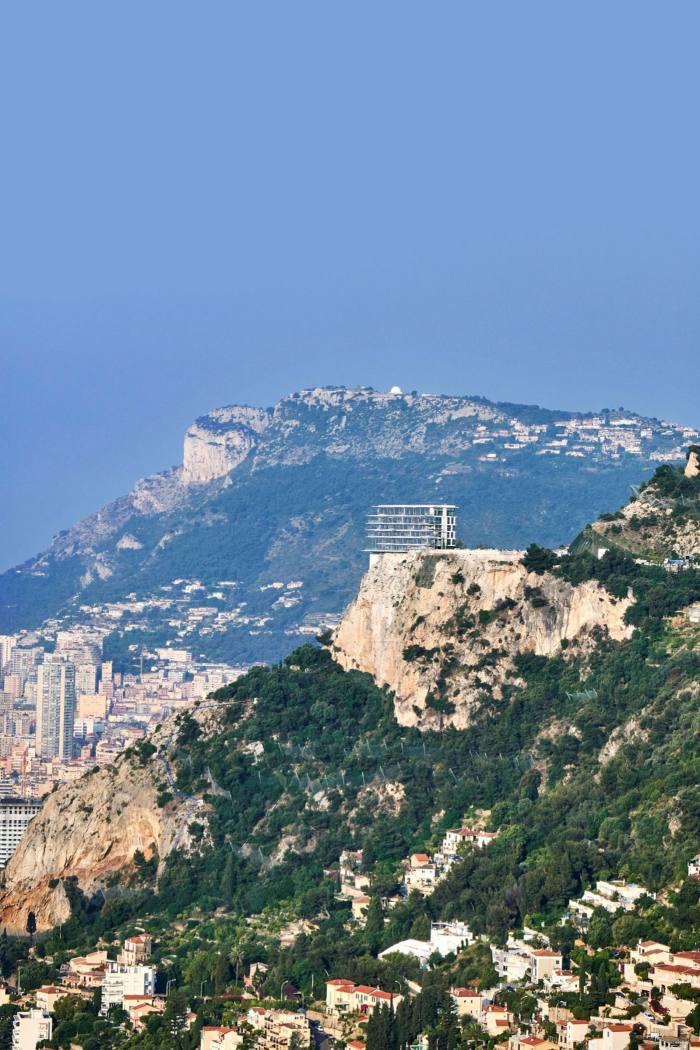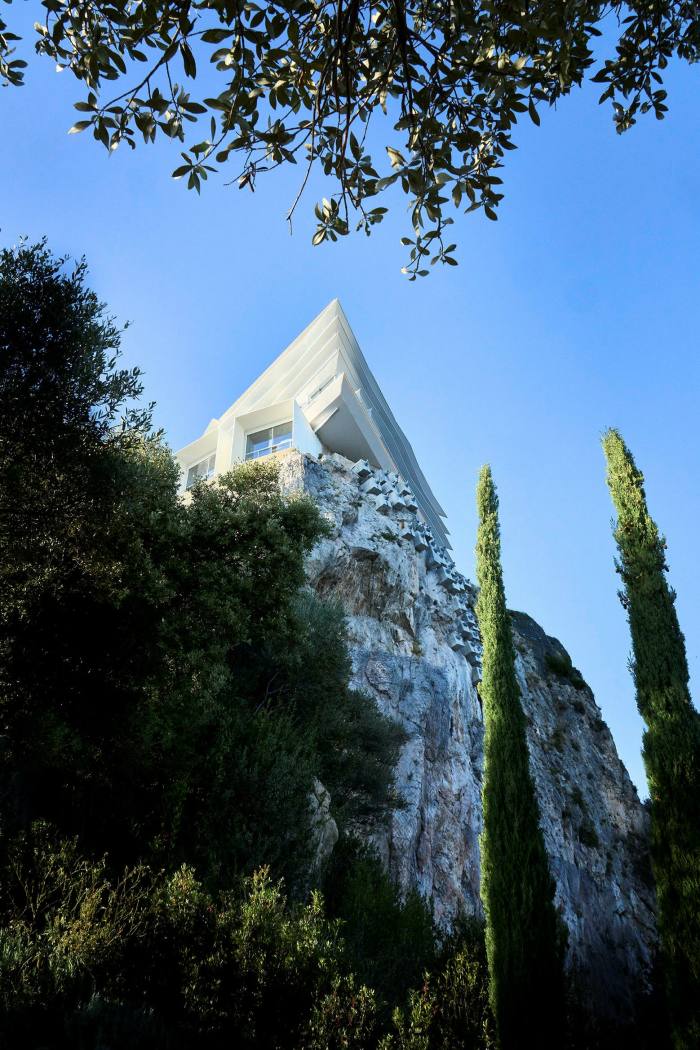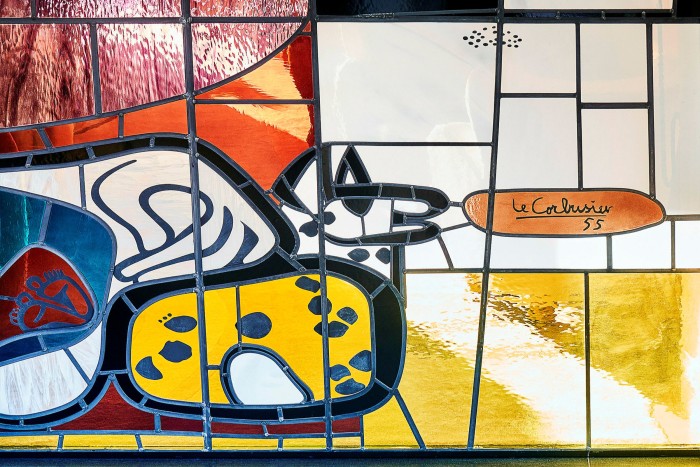Pulling in at the Maybourne Riviera on a Sunday lunchtime, with the sea sparkling below and the supercars still warm and humming from their winding drive up from Monaco, is a particular kind of experience, tinged with both a little nostalgia and a bit of sci-fi, shimmering in an irresistible hazy fantasy between mid-century glamour and retro-futurism. This new hotel, perched on the Riviera rocks way up above Roquebrune-Cap-Martin and looking down on the crush of the hypertrophied towers of Europe’s second-smallest state, appears effortlessly modern and cultishly cool.
Car doors are noiselessly opened by smooth staff in preppy seersucker jackets and white trainers, who weave between the Aston Martins and Bugattis. (A vintage Citroën DS and a Jaguar E-Type are attracting particularly admiring looks, including from me, and I’m not even interested in cars.)
Inside, guests find themselves below the legs of a suspended couple cast in shiny metal and seemingly entwined by their engorged intestines. It is, it turns out, a work by Louise Bourgeois. The hotelier Paddy McKillen later tells me he came across it in the artist’s studio after her death and had to have it. The whole lobby was designed around it and McKillen enthuses about the hundreds of other artworks he has gathered for the hotel.
Belfast-born McKillen manages the Maybourne Hotel Group, whose properties have been catering for well-heeled travellers since 1815. The group, owned by the Qatari royal family and with McKillen as a co-investor, is anchored around three London grand dames — the Connaught, Claridge’s and the Berkeley — but in late 2019 expanded beyond the British capital by acquiring the Montage Beverly Hills and relaunching it under the Maybourne name.



During the pandemic, McKillen was working on two big digs simultaneously. In London he was finishing a mega-basement beneath Claridge’s — excavated from the London clay by a team of miners from Donegal who used mattocks and shovels in order not to disturb the smooth running of the hotel above, which was, incredibly, kept fully open throughout.
Up here, meanwhile, in the rocks above the bay, his teams were blasting into the hillside to build the group’s first property in mainland Europe, created at a cost of more than €300m. It could not be further from Brook Street: a sleek, self-consciously contemporary structure somewhere between 1930s chic Med-modern, 1960s Palm Springs, 1990s Los Angeles and Thunderbirds.

I am whisked straight to my room (there is no front desk and check-in is done in the bedroom or remotely in advance). There, I am rendered mute by a view that is surely one of the greatest of hotel vistas. The L-shaped corner suite has a wraparound terrace and an expanse of twinkling, rippling blue which means that, for my two nights, I barely notice the interior, I just can’t stop looking out.
This new addition to a group of such historic hotels is an assertion that a super-luxe hotel can be contemporary without being gauche, architecturally ambitious without being pretentious and can play with ideas about style drawn from different eras and arenas without entirely committing; from nautical architecture, from the history of modernism, from ancient landscapes and from the contemporary cutting-edge.



McKillen gives me a tour. Striding fast through the site, he is most animated when he encounters the workers still beavering away on one wing of the hotel. He greets them all by name (many have Irish accents), telling them how well they’re getting on. He seems more moved by the cavernous subterranean engineering and the massive new underground car park with its careful concrete seismic detailing and steel ties than he is by the mesmeric view. “We built this in 14 months,” he says, explaining that the pandemic helped it along, with builders from other sites across Europe converging here.
There was a hotel here before, the 1970 Vista Palace, but this is a new building occupying roughly the same silhouette perched precariously atop the cliff. Maybourne acquired the site in 2015, but a long planning process meant work didn’t start until last year; the first guests arrived for a “soft opening” in September.
Despite its prominence (not just its hilltop profile but the LED lighting, which makes it hyper-visible against the dark rocks all night), the architects have made efforts to integrate the structure into the landscape of historic terraces stretching down towards the coast. Some of the rooms have been inserted directly into the hillside, like white boxes jammed into the side of a sponge.
French architect Jean-Michel Wilmotte (better known for cultural buildings including the new temporary Grand Palais Éphémère in Paris) worked with executive architect Franck Demaria to create a hotel that has endless echoes of former architectures yet looks genuinely, and surprisingly, new.
This dramatic neighbourhood is steeped in the legacy of modernism. Eileen Gray built the E-1027 villa (1926-29) for her friend Jean Badovici just along the bay when there was nothing else there (I could see it clearly from my window). McKillen was instrumental in funding its restoration and, now revived, it is clearly one of the most innovative and intense of modernist houses.

Le Corbusier became unsettlingly obsessed with the villa, building his own austere little wooden cabin right next door and later daubing murals on the villa walls (against Gray’s wishes). He also built a row of holiday cabins right above the villa on the rocks (brightly coloured for maximum visual disruption) and he died in 1965 while swimming out to sea right outside the house.
A whole seedy history of gender, sex, appropriation and design as violence is inscribed in this modernist landscape. Gray later built herself another house just along the coast in Menton and Coco Chanel designed and built her own house, La Pausa, in Roquebrune in the early 1930s.
McKillen was clearly seduced by this legacy. The lobby, dominated by the hanging Bourgeois intestine figures, also features a sliding stained glass window “based on a design for a tapestry by Le Corbusier we have displayed at Château La Coste”, his winery and sculpture park in Provence, while a white screen of interlocking elements was inspired by Gray’s famous designs.

A number of interior designers were commissioned so there is no single style but rather a kind of collection of inflections, variations on a theme. The 45 rooms and 24 suites (all of which have sea views) were designed by Michelle Wu, Pierre Yovanovitch, André Fu, Bryan O’Sullivan and my room, I was told, was by Rigby & Rigby, more known for yacht interiors than buildings, which might explain some of the oddly shaped sofas.
My tiny complaint that the over-designed desk chair was a little low might have been based on a misunderstanding. Perhaps, I thought to myself, this is entirely not a hotel for working in. The oval-shaped bath, on the other hand, carved from a single piece of marble, was a stunner — somehow simultaneously utterly excessive and oddly minimal.
At the top of the hotel is Ceto, a seafood grill with a rippling white ceiling run by chef Mauro Colagreco, revered for his three Michelin-starred Mirazur just along the coast in Menton. It is spectacular, a crystalline space punctuated by complicated and oddly charismatic cooking devices. (“We wanted to keep it light, on top of the hills,” McKillen says. “Lots of glass.”)

At the lobby level, Colagreco is also overseeing the more casual Riviera restaurant, another glassy venue giving on to uninterrupted sea views, almost floating above the panorama. The slick, clean architecture is made more dramatic by sharp angles and pointed prows. Intentionally evoking liners or yachts, it is also a little piece of craggy expressionism, carved into the rock, embedded in the topography.
The layers of rooms (still being finished when I visited) that trail off to one side are embedded into the hillside, striated like the steep, rocky tumble of terraces beneath. Some have garden terraces, others plunge pools. The spaces between the translucent privacy screens are a little tight but the expanse of the view beyond makes you forget the blinkers.
There is the occasional minor mis-step, I think, such as the infinity pool being beside the restaurant terrace. It hardly enhances the view — the sea is all around — but it did stop me from swimming while the extraordinarily elegant ladies lunched. I was just too self-conscious. On the other hand no space here seems neglected. Even the lift lobbies have uninterrupted sea views.
Every corner has been considered, every surface from the creamy terrazzo floors to the polished copper lift reveals has been treated with care and yet it never feels too much. McKillen points out the mosaic pavements outside, inspired by those by Roberto Burle Marx in Copacabana Beach and laid by Portuguese craftsmen.
I asked the hotelier how, after reworking classic hotels such as Claridge’s and the Connaught, with their particular worlds of history and association, he thinks about a brand new hotel in 2021. “I didn’t want to fake it here,” he told me. “What would we do, fake Georgian? What is 2021? We used to have a dress code at Claridge’s, ladies weren’t allowed in trousers. Now, of course, we don’t have a dress code, we don’t care what you wear. If fashion moves on, what is today? It’s not minimalism, it’s not Art Deco, or anything from the past, so this is a big experiment in freshness.
“It’s modernism,” he says. “Upbeat . . . it ticks every box for a hotel.” Then he turns to tell another worker what a great job he’s doing and, pointing to the veneer on a door that opens on to a vista of the rippling blue Mediterranean, asks, rhetorically I think: “Doesn’t that look grand?”
Edwin Heathcote is the FT’s design critic
Details
Edwin Heathcote was a guest of the Maybourne Riviera (maybourneriviera.com). Double rooms cost from €750
Follow @ftweekend on Twitter to find out about our latest stories first
Stay connected with us on social media platform for instant update click here to join our Twitter, & Facebook
We are now on Telegram. Click here to join our channel (@TechiUpdate) and stay updated with the latest Technology headlines.
For all the latest Travel News Click Here
